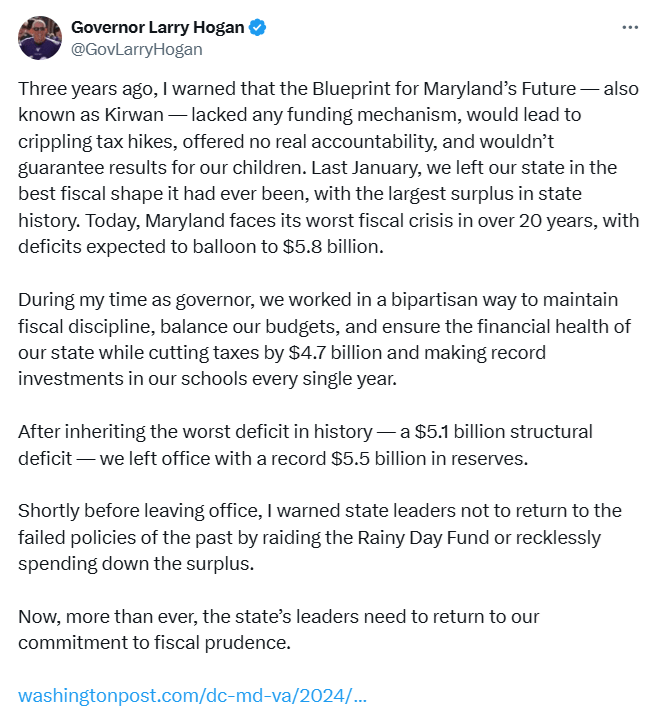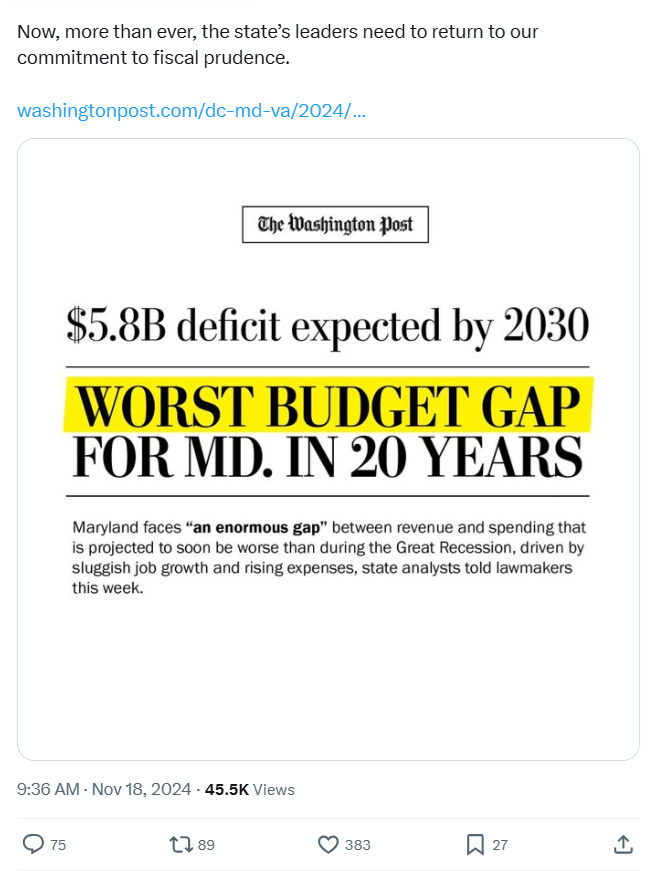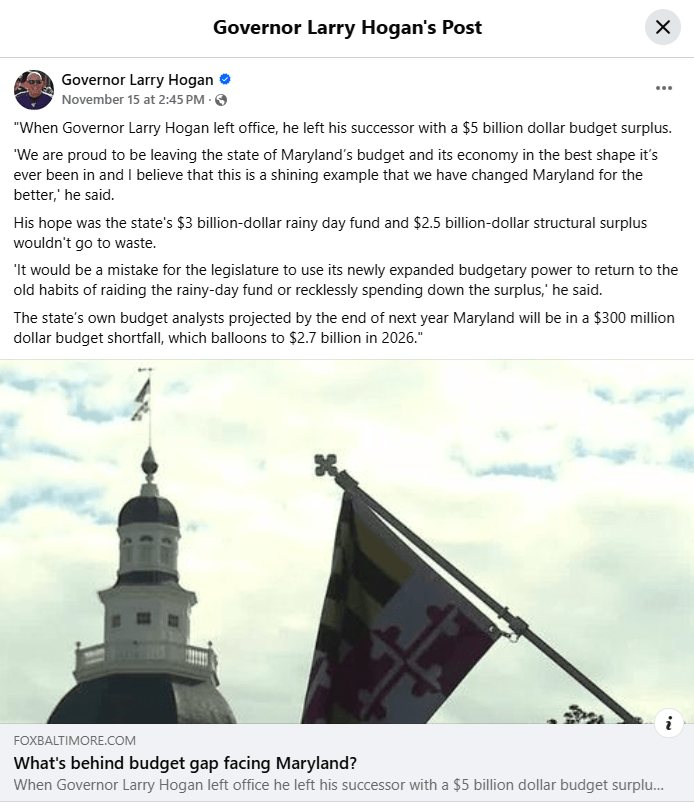By Adam Pagnucco.
Former Governor Larry Hogan just lost a U.S. Senate race to Prince George’s County Executive Angela Alsobrooks by 11 points at this writing. That comes despite nearly $27 million in outside spending against Alsobrooks (vs $16 million spent against Hogan). So Hogan is done, right?
Not so fast.
Consider this X post linking to a Washington Post article about state budget problems on November 18.


Now consider this Facebook post about the state’s budget gap on November 15. The post links to this article by Sinclair affiliate Fox 45 (Baltimore) echoing Hogan’s line.

Finally, consider a November 15 email sent out by Hogan’s chief strategist, Russ Schriefer, touting upsides to his performance despite his loss. (That email is reprinted below.) If Hogan were done with politics, why would he bother sending out an email making the case for his strength as a candidate?
It’s obvious what’s going on here. Team Hogan, like everyone else in state politics, anticipates that Annapolis Democrats will pass a massive tax hike in response to their budget problems. That sets the stage for Hogan, who won his first gubernatorial campaign in 2014 crusading against tax hikes, to mount a comeback. The incentive for GOP outside money to play is the prospect of knocking out Governor Wes Moore, a potentially attractive Democratic candidate for a presidential ticket.
But wait, isn’t Hogan prevented from running because of term limits? The answer is no, because as I have previously written, Maryland’s constitution prevents governors from running for more than two consecutive terms. Hogan can run again after sitting out one term.
None of this means Hogan will necessarily win a race against Moore. With Donald Trump once again in power, Maryland Democrats could very well turn out in high numbers in 2026, and a lot of them won’t be very forgiving of folks with a big red R next to their names. But Hogan is great at running against tax increases and a large new one will prove a useful argument for his return.
Whoever wins, a Moore-Hogan showdown would be dynamite for Maryland politics.
The email by Schriefer, Hogan’s strategist, is reprinted below.
*****
Subject Line – Re: Post-Election Analysis

From: Russ Schriefer, Chief Strategist for Hogan for Maryland
Fri 11/15/24 11:21 AM
From the moment he entered the race for U.S. Senate, Governor Hogan publicly stated that he was an underdog.
After Vermont, Maryland was the worst state for President Trump this year. Despite previously winning two gubernatorial races, Governor Hogan knew winning crossover votes in a federal election in a presidential year would be far more challenging. This environment became even more difficult in July when President Biden dropped out of the race, creating a surge of Democratic fundraising and enthusiasm that benefited the Alsobrooks campaign.
Despite coming up short, Governor Hogan won unprecedented numbers of split ticket voters and consolidated Republican support in Maryland — even in the most difficult environment.
Outperforming Top of Ticket: Governor Hogan outperformed the top of the ticket by more than any other statewide candidate, Republican or Democrat, in America. This includes incumbent Democratic Senator Jon Tester and Nebraska Independent Dan Osborn. Governor Hogan expanded the tent and brought voters to the polls. Maryland was the only competitive Senate race in the country where more voters cast their ballots for senate than president.
Best Performance Since 1980: Governor Hogan came the closest to winning a Senate seat as a Republican in Maryland since 1980. As returns continue to be counted, we expect that Governor Hogan will receive more votes than he did in 2018.
Sustained Popularity: Despite tens of millions of dollars of attack ads, Governor Hogan’s image remains overwhelmingly popular in Maryland. In late October, our polling showed Governor Hogan held a 61% favorable rating. Meanwhile, despite lower name recognition, Alsobrooks had a higher unfavorability rating than Governor Hogan.
Control of The Senate: This race was decided based on national factors and a false narrative driven by media coverage. Republicans were always nearly guaranteed to control the Senate without Maryland. However, according to our internal polling, nearly 80% of those voting for Alsobrooks did so for the reason of maintaining Democratic control of the Senate. Our polling also showed that this message had already sunk in by early June — suggesting media coverage about Senate control played a bigger role than paid advertising in shaping voter perception.
Expanding Donor Base: Governor Hogan successfully grew the fundraising pie, attracting thousands of politically diverse donors who were uniquely attracted to his message and unlikely to give to other races. Meanwhile, the Alsobrooks campaign largely sucked up resources from other races without attracting new donors.
Sincerely,
Russ Schriefer, Chief Strategist for Hogan for Maryland
